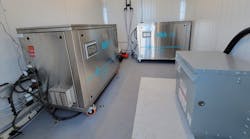According to the experts we speak with regularly, the membrane market offers steady business and stable profits for most water treatment dealers. Anisotropic membranes, which are used in reverse osmosis (RO) systems, have a reputation for effectiveness in filtering out water impurities. For example, a quality RO membrane will have a rejection rate of 99.5 percent, which is almost a perfect reduction of sediments and dissolved solids. And, another example, these membranes are also effective at lead removal because the membrane removes not only the soluble lead impurities by 90 to 95 percent, but it can also act as a barrier to particulate lead.
Educated customers cannot dispute RO’s effectiveness, versatility or popularity. However, these same savvy customers are also aware of the technology’s drawbacks, such as energy requirements, disinfection capabilities and, of course, product water to wastewater ratio. Sustainability-minded customers will surely want the most effective solution available for problem water, while also having as less of an impact on the environment as possible.
We recently spoke with two prominent players in the market to see what improvements in energy and waste have been made in recent years, and also what is on tap for the future.
Power play with performance
Assuming a quality system is purchased and installed by a trained professional, an RO unit’s performance and energy demands should only slightly vary through the course of its life in most standard applications. However, there are certain variables that impact RO technology, including:
- The quantity of permeate water produced
- The quality of the water being treated
- Pressure applied to water/flow rate
- Water temperature
- Recovery
- Certain contaminants, such as specific pesticides, toluene, cyanide, chloroform and calcium
- Total dissolved solids (TDS)
- Hardness, typically above 12 gpg
- Chlorine
- High silica levels.
“Chlorine attacks the polyamide layer (of the membrane), altering its configuration, leading to membrane degradation and decreased permeate quality,” says Martin You, marketing communications specialist for CSM.
And, high levels of certain contaminants, such as silica and total suspended solids (TSS), can plug membrane and increase the unit’s demand for energy.
“As the membrane plugs, the flow rate decreases,” explains Chia Kung, global product manager for Pentair’s filtration technologies division. “So, to overcome that decrease, you have to apply more pressure, increasing energy needs. Therefore, if you can maintain the original flow rate of the membrane (low fouling), then you can reduce the amount of energy required to drive water through the element.”
In addition to pretreatment, there are membranes available that are specifically designed to reduce fouling.
Low energy options
Pressure, measured in psi, is required to push water through an RO membrane in typical residential and light commercial applications. A standard of 60 psi is recommended for these settings and at that flow rate, about 18 gallons of water per day is able to pass through the system. However, new low energy membranes for the residential market are capable of handling up to 150 gallons.
“The way low energy RO membranes function is they are operated at lower pressures (20 psi versus standard 60 psi) in a POU RO unit,” explains You. “Low energy RO membranes are different from traditional membranes in that the polymer configuration of the polyamide coating (thin-film composite) is different.”
However, continues You, due to the low operating pressure mineral rejection is decreased — from nominal 98.0 percent NaCl rejection at 200 mg/L to minimum 95.0 percent, for example. “Yet, low pressure membranes may be ideal for situations where energy is out-of-reach, such as natural disaster emergencies and third-world countries,” adds You.
Water treatment dealers, as mentioned, should also be aware of the customer’s current water quality when determining if low energy membranes are suitable. Testing for TDS, for example, is good practice when considering a low energy membrane.
“When you have high TDS, low energy membranes don’t particularly perform as well because the rejection rate is compromised,” says Kung, adding that less than 1,000 ppm of TDS is ideal.
Membrane fouling and waste concerns
Dealers can offer energy- and environment-minded customers fouling resistant RO membranes. These membranes help reduce energy requirements because fouling may increase feed pressure during RO operation. When this happens foulants may become clogged on the membrane layer.
Fouling resistant membranes are designed to help reduce the amount of foulants and dissolved minerals that can cause clogging. For example, offers Kung, there are chlorine tolerant RO membranes on the market.
Still, regardless of the type of membrane installed, RO membranes can be vulnerable if pretreatment and testing are not performed up to industry standards. Often, adds Kung, as long as dealers can maintain pretreatment a quality RO membrane can last up to 10 years.
Dealers should proactively check pretreatment filters to prolong the RO membrane’s lifespan. And, asserts You, research new technologies that are available to minimize RO fouling potentials.
Moreover, the same customers who are mindful of energy concerns regarding RO units and membranes are the same customers who are aware of the technology’s waste to product water ratio. A lower end RO unit will produce one gallon of drinking water to every eight to nine gallons of wastewater. A higher end system will maintain a one to two or three ratio, says Kung.
“Water waste has been an Achilles heel for RO technology,” notes Kung. “However, I see a change where efficiency and the idea of throwing less water down the drain is becoming important, especially in areas where strict water restrictions are in place. Membrane companies are optimizing designs and combining with different technologies to enhance efficiencies [in this area].”
However, for customers that enjoy RO's diverse capabilities and effectiveness and would prefer the technology over others, there are green messages to share. RO concentrate (reject) can be collected and used for such activities as watering plants.
Although a highly effective technology, RO’s energy and wastewater drawbacks have the potential to concern some customers, and dealers should be sensitive to this. Customers need to be assured that research done online or through casual conversations with others can be misleading and false. Water treatment dealers can help to overcome these sales challenges when they properly educate customers that there are ways, such as those outlined in this article, to help minimize RO’s impact on the environment.


